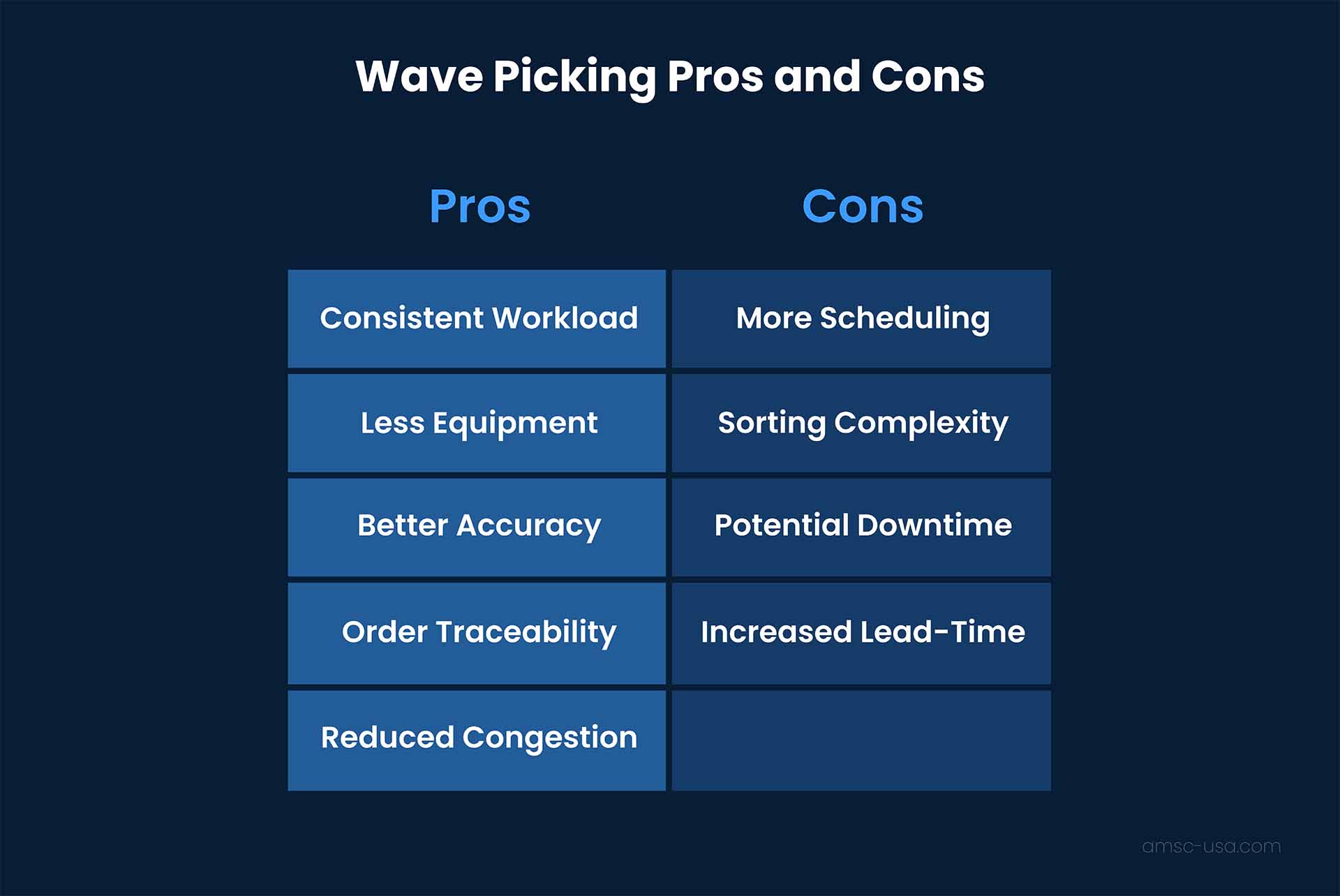What is wave picking? Benefits of Wave Picking in Your Warehouse
In pick pack and ship operations, the main goal of a warehouse is typically reducing the amount of time required for each pick. There are several picking strategies to assist with optimizing this number. In this article, we examine the picking strategy known as “wave picking”.

Table of Contents
What is wave picking?
Wave picking is the type of order fulfillment where orders group together by SKU or item. These groups are picked together all at once instead of individually. This group of picks is called a wave, hence the name wave picking. In this way, workers are picking orders together all at once rather than throughout the day.
There are several variations of wave picking, however they all involve some sort of grouping of picking schedules. As mentioned, they are usually by item or SKU. Sometimes, however, waves schedule together based on carrier pickup times, or even customer preferred shipping schedules.
Often, wave picking combines with other picking strategies such as zone picking or batch picking. As you scale your warehouse operations, you may decide that even greater efficiency is possible by unique combination picking strategies like this.
There are several other types of picking in a warehouse. You can read about them in the articles linked below:

How does wave picking work?
Wave picking works by grouping orders together in the warehouse management system (WMS). Whichever WMS you utilize, it must have the capability to take orders and group them according to your specific wave picking strategy. If it’s strictly based on SKU counts, then it should take into consideration your typical order volume for each day. Based on this data, the system can schedule certain workers for those orders all at once.
Once the system organizes orders according to your requirements, it should create picking lists for each worker scheduled in the process. This should also be organized based on the most efficient use of the worker’s time and location. Often, this is where a zone picking strategy combines with the wave strategy.
Warehouse pickers then follow the pick list and pull the items for a slew of orders all at the same time. Typically these go into one large bin and sort by order in the final packing phase.
Types of Wave Picking
When considering wave picking, it is helpful to separate them into two main types: fixed wave picking and dynamic wave picking. Both of these types define by when and how the orders pack for shipping.
Fixed Wave Picking
When the packing phase waits to engage until all the items in a wave are picked, this is fixed wave picking. The advantage for this method is adding the flexibility to schedule your packing crews in-line with when items are ready. In this way, the “wave” applies for both the picking and the packing warehouse employees.
The downside to fixed wave picking is that more organization is required. If your warehouse is not managed properly, or does not have enough scale, fixed wave picking may only add complexity to your picking process.
Dynamic Wave Picking
When the packing of items happens simultaneously with the picking, this is called dynamic wave picking. The advantage for this method is that your packing crew can remain the same while your picking team can become more flexible. It’s less complex than fixed wave picking because you only need to schedule the wave of the picking team.

Why use wave picking? Advantages of Wave Picking
The main goal of any picking strategy is to reduce the time a worker spends for each pick. This way the cost per order is minimized as much as possible while maintaining good order accuracy. However, some picking strategies carry other benefits over just picking efficiency. Here are some advantages to the wave picking strategy:
Consistent Work Load
The wave picking process enables a more consistent work load across warehouse workers. This is because it’s a schedule based picking strategy rather than as-required. Workers start with a list of orders and work until the orders are all completed before moving onto the next wave. When done correctly, productivity should skyrocket and workers will also take more pride in their work.
Less Equipment Required
Most of the time, wave picking uses a single bin to place all the items into. This differs from batch picking or zone picking where different items pick together. In those strategies, individual orders pick at the same time regardless of what SKU or item is on the order. This means they need to be segregated at the time of the pick which creates a need for a larger set of segregated bins to roll with the warehouse picker.
Better Order Accuracy
It makes sense that the order accuracy would increase if warehouse workers only pick one SKU at a time. In fact, it doesn’t matter the number of orders in the system, as long as they are the same SKU the order accuracy should be perfect. While there are some edge cases, this is a big benefit to the wave picking method.
Order Traceability
Because orders are grouped together at particular times when waves are scheduled, they are all trackable. This means that if there was an error somewhere in the order picking, a manager can return to that specific time and determine exactly where the error happened (and why). This is far simpler to accomplish than a piece picking method.
Less Interference
Because waves are scheduled for specific times, your order picking can occur completely outside of all other warehouse activities including other types of fulfillment. Warehouses often suffer from congestion or traffic from running multiple orders for customers at the same time. Wave picking enables your labor to work during off-peak hours or at times when other single order shifts are not in the way.
Disadvantages of Wave Picking
Wave picking has lots of advantages. But no system is perfect and it carries with it some disadvantages too. As you may find, most of these disadvantages result from a lack of planning or even the overall scale of the warehouse operations.
Increased Scheduling Oversight
Because there is more involved with scheduling waves, this can be cumbersome or even impossible for small operations. If your warehouse management system or managers are not up to the task, attempting a wave system may cause more damage than good.
Sorting Area Complexity
Wave picking orders usually requires a sorting area to perform all of the tasks for placing items into groups by order. If your sorting or packing area do not have the productivity or are unable to complete the sorting fast enough, it could create other bottlenecks. This could also reduce order accuracy and introduce errors.
Picking Downtime
If waves are not scheduled appropriately, or there is not enough work to schedule simultaneous shifts of waves, then you will have extra picker down time. Warehouses need to determine if this method is right for them based on the complete picture of all their picking activities at each location.
Increased Lead Time
If your customer requires fast order lead time, then wave picking orders may not be the right order picking method. This is because a wave schedule may not occur for another 24 hours after the order comes into the system which could place it on the next day to complete. In these cases, schedules can alter slightly if enough orders warrant a new wave to meet the requirements of the business.

Wave Picking vs Zone Picking
Wave picking resembles an older and more popular method of picking, zone picking. Rather than by the time at which the picking occurs, zone picking is characterized by the location of pick. The two approaches are not necessarily exclusive – some warehouses use both.
In fact, you can combine the two efforts into something called zone-wave picking. This type of combined picking method places works in particular warehouse zones on schedules according to certain criteria like the wave method.
Depending on warehouse size, zones may break down in different ways. Sometimes it’s based on a particular set of SKUs, and others may be organized based on total coverage area per picker. Others may even dissect zones based on what kind of total sales volume a particular zone sees, or even what kind of products exist in those areas. This may include hazardous materials, or larger bulky and heavy items.
Regardless of how you break down the zones, a picker is assigned to their own area where they exclusively pick. Instead of moving across the entire warehouse for each order, they only move within their specific zone. This reduces the amount of wasted time for each picker in their location.
How to Optimize Wave Picking
There are several ways to ensure your wave picking process is as efficient as possible. You should consider these optimization tips before deciding on implementing your wave methods. If you don’t you could face significantly reduced efficiency and increased amounts of complexity for your warehouse.
Measure Your Order Volume
Before jumping into wave picking, you should make sure your order volume is high enough to overcome its potential disadvantages. What is the total number of orders for a particular time period, SKU, or delivery methodology? If you don’t have enough total quantity of orders in the particular wave method you are aiming for, your efficiency will decrease and your picking process won’t help you.
Decide How the Wave Should Organize
A wave picking process must schedule according to a particular group of attributes. Most often these are by SKUs, delivery and shipping times, and even other warehouse operations ongoing in the business. The decision should drive based on your customers requirements and how efficiently you can manage the various methods of wave picking.
Visualize the Wave
This really just means plan out every step of the process before jumping in. Grouping orders together rather than piece picking or batch picking means that your various locations may have more or less congestion depending upon when pickers are present. You should also consider the amount of time required for each wave to to complete their shift. Consider how many managers you may need to add in addition to regular labor. If you cannot maintain a consistent shift of waves in your planning, then it’s possible wave picking orders is not the right method for you.
Create a Sorting Staging Area
Since most wave methods involve a grouped set of orders together that pick simultaneously, you will likely need a larger area for sorting. If your current warehouse layout wont accommodate this, you will need to devote a location for the completed order picks so the sorting crew can organize them.
Plan Your Labor
Since your order picking crews will work in waves instead of ad-hoc as orders arrive, your labor requirements may change. The number of total pickers may reduce, but if you add sorters, then your total required labor force may be more than you thought. Keep in mind that labor may change throughout the day as scheduling waves may only occur as needed instead of constantly. Some warehouses effectively schedule one wave per day using existing pickers.
Check Your Warehouse Management System
Wave picking requires a powerful software system that can manage complex data analysis to determine the best possible method for batches wave picking. If your WMS is not capable of scheduling a shift or multiple shifts of waves, then you may need to upgrade before attempting to adopt the method.
Ask For Help
Sometimes you need advice from someone who has already implemented whatever you are currently considering for your business. Getting feedback from multiple other business operations as well as your own managers will help you decide on implementation. You may even find from these conversations that batch picking or some other method is preferred.

Is wave picking right for you?
Whether you choose to implement waves into your picking plan or not is a decision that hopefully you now have some information to base your decision on. Of course there are many picking methods such as batch picking, zone picking, and piece picking. However a good understanding of the efficiency of each type will enable your business to make the right decision that fits your needs and the needs of your customers.
We have written more on this topic. For more information on optimizing your warehouse picking, see our article, 12 tips to pick faster in a warehouse.
